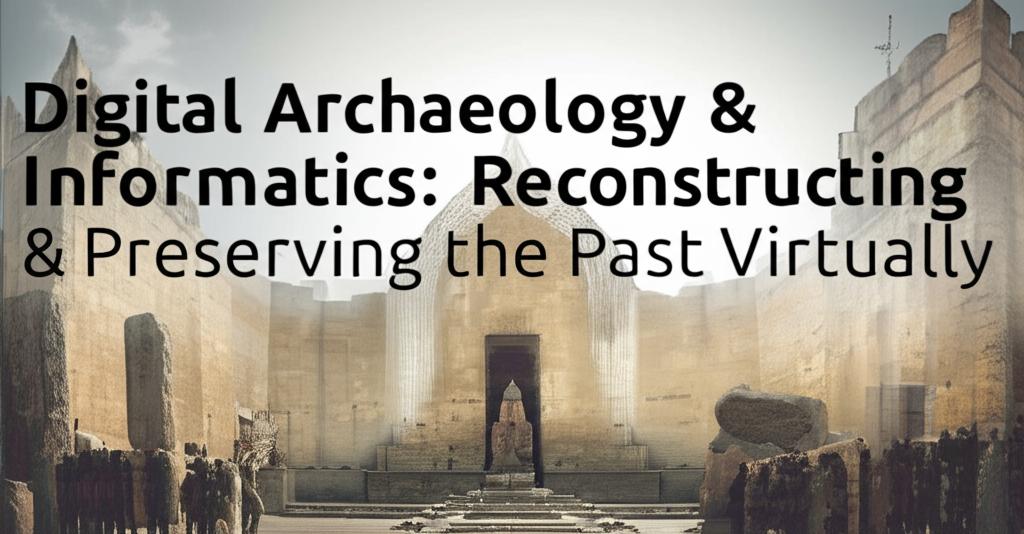The allure of the past is no longer confined to dusty archives and remote excavation sites. Today, the fascinating worlds of Digital Archaeology and Heritage Informatics are throwing open the doors to history, allowing us to reconstruct and preserve bygone eras with unprecedented accuracy and immerse ourselves in them like never before. This rapidly evolving field is a vibrant intersection of cutting-edge technology and ancient mysteries, offering breathtaking new ways to experience and understand our collective heritage.
Imagine walking through the bustling streets of ancient Rome, witnessing the construction of the pyramids, or examining delicate artifacts too fragile for human touch. These are no longer futuristic fantasies but increasingly tangible realities, thanks to a sophisticated toolkit that includes 3D laser scanning, photogrammetry, Artificial Intelligence (AI), and Virtual and Augmented Reality (VR/AR).
Digitally Unearthing and Reconstructing the PastArchaeologists are now "digging" with data as much as with trowels. Non-invasive techniques like LiDAR (Light Detection and Ranging) can penetrate dense vegetation to reveal hidden structures and entire ancient cities, while ground-penetrating radar maps subterranean features without disturbing the earth. Drones equipped with high-resolution cameras capture vast amounts of aerial data, which, through photogrammetry, can be stitched together to create detailed 3D models of entire archaeological sites. These digital blueprints not only aid in excavation planning but also form the basis for stunningly accurate virtual reconstructions.
AI is proving to be a game-changer in this domain. Machine learning algorithms can analyze satellite imagery to identify potential new archaeological sites with remarkable accuracy, even in remote or inaccessible areas. AI can also sift through massive datasets of geological information for predictive studies, helping to pinpoint areas of interest that might have otherwise gone unnoticed. Furthermore, AI is being employed to piece together fragmented artifacts, decipher ancient texts, and even assist in the delicate physical restoration of objects. For instance, AI-driven robots are now being used to repair delicate artworks from Pompeii.
Preserving Heritage in the Digital RealmBeyond discovery and reconstruction, digital technologies offer powerful solutions for preserving cultural heritage. 3D scanning and modeling create "digital twins" of artifacts, monuments, and even entire heritage sites. These highly accurate digital replicas serve as invaluable records, safeguarding our heritage against the threats of time, conflict, and environmental damage. They ensure that future generations can study and appreciate these treasures, even if the physical originals are lost or degraded. Digital archives provide a secure and accessible repository for this wealth of information.
Step Inside History: Immersive Experiences and Digital StorytellingPerhaps the most captivating aspect of digital archaeology and heritage informatics is the ability to bring the past to life through immersive experiences. VR and AR technologies allow us to step directly into reconstructed historical environments. Imagine exploring a meticulously recreated 15th-century courtroom or wandering the streets of an 18th-century Amsterdam neighborhood. These virtual experiences, often enhanced with digital storytelling, offer engaging and educational ways to connect with history on a more personal and emotional level. Mobile applications are increasingly incorporating AR and VR to provide interactive and gamified heritage experiences, making learning about the past more accessible and appealing, especially to younger audiences.
Digital storytelling itself has become a powerful tool, combining multimedia elements to create compelling narratives around cultural artifacts and historical events. This not only enhances public engagement but also empowers communities to participate in the preservation and interpretation of their own heritage.
The Future is Now (and Then)The synergy between technology and archaeology is constantly evolving. Researchers are exploring new ways to combine AI with 3D modeling to automate and refine the creation of digital heritage assets. The development of international frameworks for image interoperability is making it easier to share and study high-resolution digital cultural heritage data globally.
While the possibilities are immense, there are also challenges to address, including the need for specialized expertise, robust data management systems, and ethical considerations surrounding digital ownership and access. However, the drive to unlock new dimensions of human history and ensure that the legacy of ancient civilizations endures for future generations is a powerful motivator.
Digital archaeology and heritage informatics are not just about looking back; they are about forging a new relationship with our past – one that is more interactive, more insightful, and more inspiring than ever before. As these technologies continue to advance, the ways in which we reconstruct, preserve, and experience history will undoubtedly become even more extraordinary.

